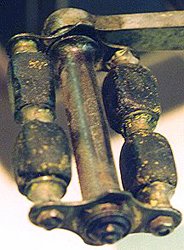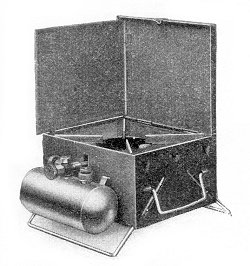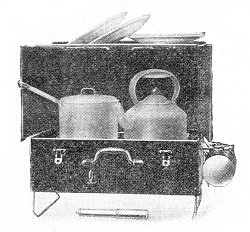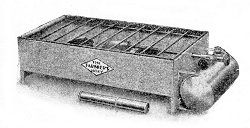The Villiers Engineering Co. Ltd.
Other Products
| The Curator is pleased to display here some things
other than engines which Villiers made. How many such other
things there were, he has no idea. But here are some that are
known about. |
 |
This pedal, photographed on a Sunbeam bicycle at the
National Cycle Museum, would have been made by Villiers. Then they
started making freewheels. |
| Something else Villiers were in to was petrol
stoves. So far we do not know when they started making them,
or why, or when they stopped making them. But here are some,
all of them found in the John Shaw and Sons catalogue for 1939: |
| This is the "Mar-Vil". It had a single burner and
could boil a quart of water in less than 4 minutes. The finish is
black enamel and chromium plate. The back and side shields, and
the legs, all folded down. |
 |
 |
This is the "Inferno", which had two burners and a plate
rack. (These days an advertiser would have to add "plates not
included"). Its materials and finish are the same as the Mar-Vil
but Shaws add that this is made out of strong sheet steel - presumably
the Mar-Vil was as well. The Inferno "shuts down like an attaché
case in one minute". |
| This is the "Farmer's Glory". It cost the same as
the Inferno and performed the same. But it does not seem to fold
up. The only difference noticeable in Shaw's text is that in this
case they mention that the burners "can be regulated from powerful flame
to gentle simmer". |
 |
| Charles Palfreeman tells us that the name "Mar-Vil"
was also used for a stationary engine made in collaboration between
Marston and Villiers. This suggests that this stove may have
originated in some such co-operation. Then, of course, there is
the matter of outboard engines. Seagull outboards seem
originally to have been made by Sunbeam. But there is a
Seagull outboard engine in Bantock House Museum in Wolverhampton
which was given to them as a Villiers outboard. The name
prominently displayed on it is Villiers. Locally it has been
assumed that it was, at least originally, a Villiers product.
But it now turns out that this was not. It is only one of the
myriad of things which used a Villiers product within it.
Charles Palfreeman tells me that the outboard was designed by
Marston's and that the engine used the Villiers magneto and
continued to do so for decades. We eagerly await publication
of his full findings.
|
|

|
|

|
|
 |
|
Return to
Stationary Engines |
|
Return to the
beginning |
|
Proceed to
Technical Details |
|